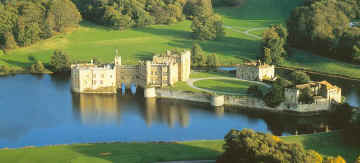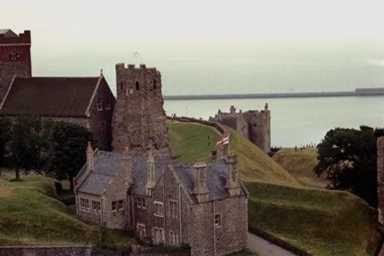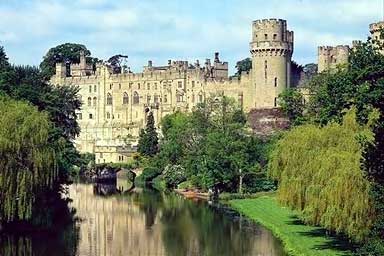|
Location:
Warwick Country
Warwick
Castle was founded in 1068 and was rebuilt and updated a number of times.
Today it combines castle ruins, largely of the fourteenth century with one
of the finest great houses in England. Two small projecting towers, which
date to the late fifteenth century are said to have built as artillery
platforms. Warwick Castle rises like a precipice above the River Avon. On
this natural cliff William I founded a motte castle in 1068, on lands
seized from a nearby Saxon convent. A wooden tower built on the motte was
evidently still there in the reign of Henry II, by which time a polygonal
shell enclosure had been raised round the motte top. Only fragments of the
shell enclosure now remain, incorporated in the rebuilt shell, which is of
much later date.
Late in the
fourteenth century, by which time some additional buildings such as the
great hall and residential blocks had been put up in the bailey, the castle
passed to Earl Beauchamp who initiated a fresh programme of works. These
were substantially what can be seen today. They included restructuring the
great hall and a range of other buildings on the south-east, a water-gate,
and on the west front a high and stout defensive curtain leading from a
gatehouse to a very tall polygonal tower, known as Guy's Tower, which is
39.4 metres tall. The gatehouse is a remarkable building: a pair of towers
above the doorway passage, which had portcullises and murder-holes.
Projecting from the east side of the gatehouse is a tall rectangular
building leading to another tower.
This latter
tower is 45.2 meters tall and capped by a two-fold system of battlements
with machicolation all round below the battlements. It is called Caesar's
Tower. The three main storeys in the tower are each vaulted, and have stone
fireplaces.
The castle
is completed by curtain walling and further, much smaller, flanking towers.
The wall at the west leads up the motte to the restored shell enclosure and
down again southwards to the south range. The whole is thus a powerfully
defended enclosure
Leeds Castle

Location:
Kent
Leeds Castle,
acclaimed as the most romantic castle in England, is located in
south-east England, built on two adjacent island in the river Len.
Leeds Castle
was originally a manor of the Saxon royal family possibly as early as the
reign of Ethelbert IV ( 856-860). The first castle was an earthwork
enclosure whose wooden palisade was converted to stone and provided with
two towers along the perimeter. This is now vanished. Traces of arches in a
vault thought to be Norman were found at the beginning of this
century.
Around 1119
Robert Crevecoeur started to build a stone castle on the site, establishing
his donjon where the Gloriette now is. Stephen, Count of Blois, and his
cousin the Empress Matilda contested the crown of England. In 1139 Matilda
invaded England with the help of his brother Robert, Earl of Gloucester,
who held Leeds castle, but Kent was loyal to king Stephen and following a
short siege he took control of the castle.
The castle
came into the possession of Edward I (1278) . He rebuilt much of the castle
as it stood at the beginning of his reign, and enlarged it, providing an
outer stone curtain round the edge of the larger island, with cylindrical
open-backed flanking towers and a square-plan water-gate on the
south-east. The gatehouse at the south-west, a single tower pierced by an arched
passage was improved. Later on, King Edward, the Confessor granted the
manor to the powerful house of Godwin.
Henry VIII,
the most famous of all the owners of Leeds Castles, expended large sums in
enlarging and beautifying the whole range of
buildings. At the
same time, he carefully retained the defenses of the castle for he often
had cause to fear invasion from either France or the Spanish . The king
entrusted the work of alteration to his great friend Sir Henry Guidford.
Leeds has been
constantly inhabited and rebuilt since then. Most of the castle today is
the result of the nineteenth-century reconstruction and addition. In
1926 Leeds was bought by the Hon. Mrs. Wilson-Filmer, known as Lady
Baillie. Immediately she began the restoration of the castle that took her
over 30 years to leave it as it stands today.
MEDIEVAL SIEGE
There are many myths and legends surrounding castle sieges. Knights
in shining armor riding up to the castle, doing hand to hand combat. Or
maybe hundreds of guards streaming out of the castles to meet their enemy.
None of this is true, except in fairy tales and movies.
Most of the
time, the attacking force would send a messenger to the lord of the castle
and give notice of their intentions to attack. This notice allowed the
castle to surrender. Sometimes the lord surrendered, but most often the
castle was restocked and made ready for the siege. They would restock
themselves with food, supplies and drink, and add men to the garrison.
There were
three ways to take a castle. The first is not to attack the castle at all -
just avoid the castle altogether and seize the lands around it. The second
is direct assault, or laying siege to the castle. The last is besieging.
Here is an
account of a siege. Stone throwing mangonels attack the towers and walls
every day. The walls of the castles would hopefully be breached, and towers
damaged. The enemy erects wooden towers called belfries, taller than the
castle towers, to conceal and enable bow men to shoot arrows down into the
castle. While this is going on, miners would be tunneling under the walls
and towers of the castle in preparation to collapse them.
To counter
the mining, anti-mining tunnels could be dug by the castle soldiers, which
insured a ferocious hand-to-hand battle underground. Inside the castle, the
guards would place a pot of water near the castle towers and walls. When
the water rippled, they would know enemy miners were at work underneath
them.
The barbican
is next assaulted and taken, with a loss of men on both sides. Then the
bailey is attacked, and more men killed. Animals and some supplies would be
captured. The auxiliary buildings containing hay and grain for the castle
are burned. By now, miners have succeeded in collapsing a wall of the
castle. The attackers have broken through and seized the inner bailey. More
men on both sides would be lost in this phase of the attack.
By this
time, the castle defenders would have retreated to the keep. Miners would
now be setting fire to the mine tunnel under the keep. The
keep. Smoke and
fire are rising into the keep, and cracks appearing in the thick walls. The
defenders of the castle are forced to surrender as the castle falls to the
enemy.
The third
method, called besieging, would require the enemy to wait and starve the
castle garrison into surrender. This method was preferred by an attacking
side. Some sieges of this type would last from six months to a year.
Sometimes, the enemy would hurl dead animals into the castle grounds in
hopes of spreading diseases. And, sometimes the lord of the castle would
toss dead animals outside his castle, to convince the enemy they had enough
supplies to carry on a siege for months.
.
CASTLES WITH GHOSTS
What
story would be complete without a haunted castle. Here is some of the
castles that are reportedly haunted in England.
Berry Pomeroy Castle, Devon Said to be
haunted by the daughter of a wicked baron who, as a consequence of an
enforced relationship with her father, bore him a child, which he
strangled.
Dover Castle, Kent
Dover Castle is associated with numerous ghosts
and strange sounds. In the King's bedroom, the lower half of a man has
been seen walking through the doorway. The specter of a woman dressed in
a red dress has been seen at the west stairway of the keep. The sounds of
a creaking doorway opening and closing where a door used to be, but isn't
anymore, have been heard.
Featherstone Castle, Northumberland The castle is associated with a ghostly bridal party.
Baron Featherstonehaugh had arranged for his daughter to marry a relative
of his choice, even though the daughter was in love with someone else.
The wedding party left for the "traditional hunt" after the
wedding, leaving the baron behind to make arrangements for the banquet.
When the party failed to return by midnight, the baron began to fear the
worst. Sitting alone at the table, he heard horses crossing the drawbridge.
The door opened and the party entered. But, they made no sound and passed
through furniture. The wedding party had been ambushed and killed. On the
anniversary of the wedding, the party can still be seen heading towards
the castle. .
Lowther Castle, Cumbria Haunted by Sir James Lowther. He was very unhappy with
a prearranged marriage, and fell in love with a farmer's daughter. When
she suddenly grew ill and died, Sir James refused to believe she was dead
and left her on the bed. She was finally moved and placed in a coffin
with a glass lid, which he set in a cupboard where he could look at her.
She was finally buried, and Sir James died unloved and unmourned. At his
funeral his coffin began to sway as it was lowered into the ground. His
spectral coach and ungroomed horses can be seen being driven through the
parklands of the castle.
Tower of London
In 1816, a guard saw what he described afterwards as
"a shadowy bear walking up the stairs in the twilight." He
lunged at it with his bayonet, which shattered against the wall. The
ghostly presence walked on unaffected and the guard, having told his
unlikely story to others, died of shock a few days later.
Windsor Castle, Berkshire Queen Elizabeth I's ghost has been seen in the library.
A young guard shot and killed himself and another guard on duty saw him
afterwards.
|
|


